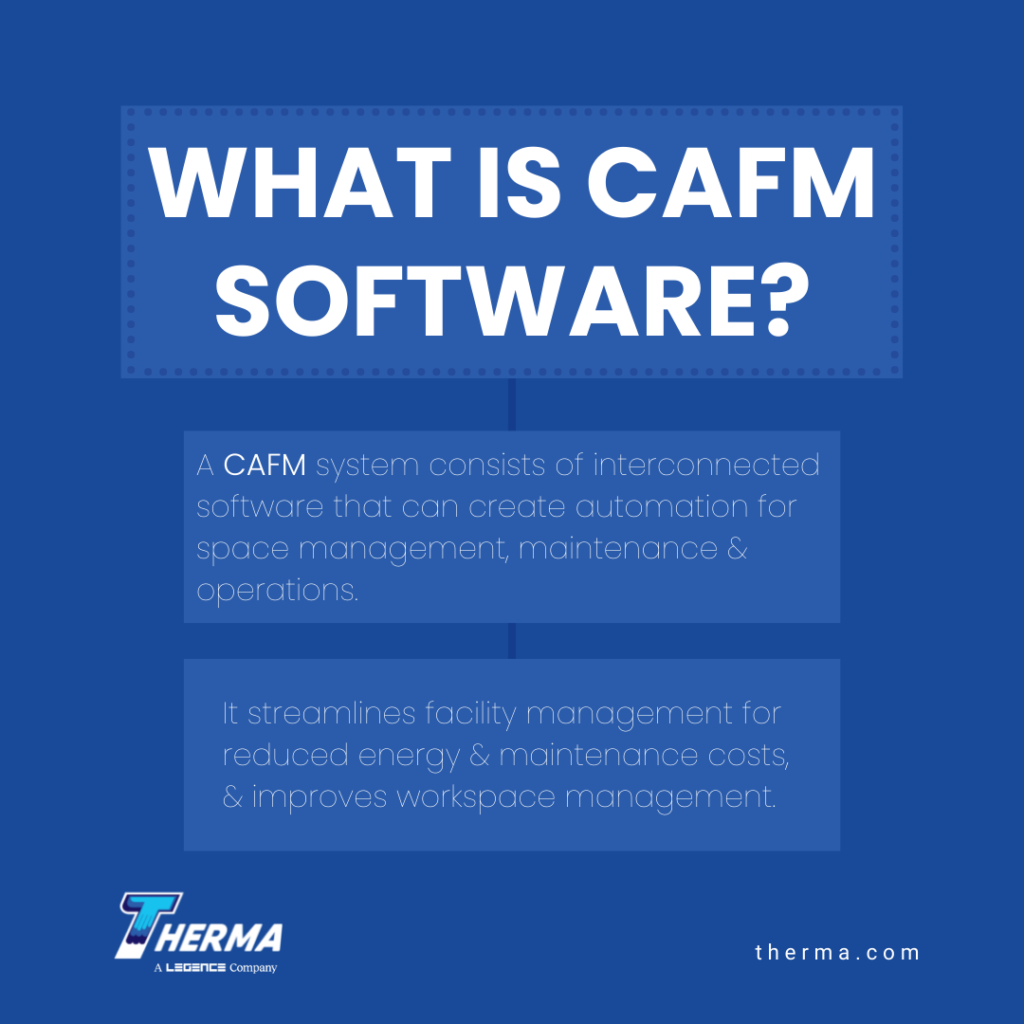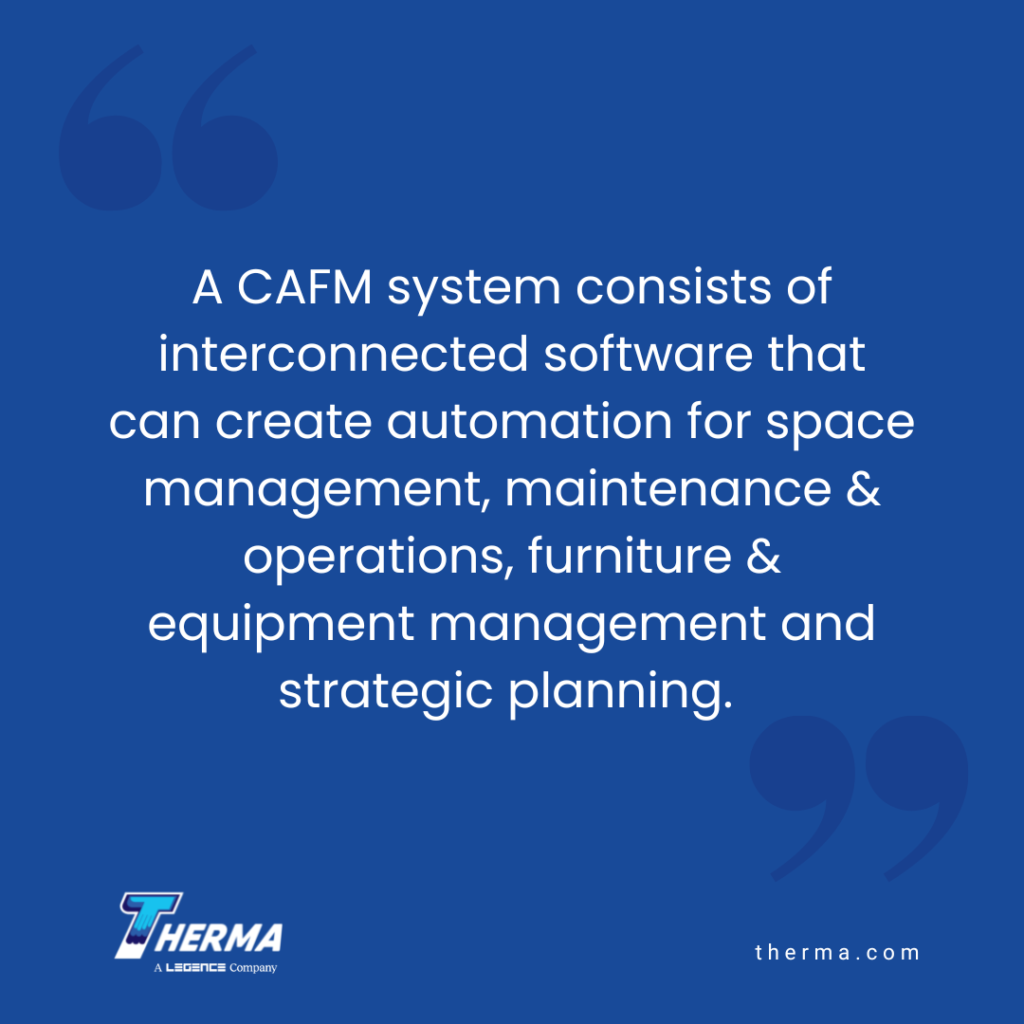by Ali Kriscenski
Digital systems have infiltrated most aspects of daily life, including building operations. Computer aided facility management (CAFM) software allows facility managers to efficiently plan and monitor operations including space allocation, fleet and asset management, preventative maintenance and employee and customer services. Integrating existing building and business systems, CAFM software streamlines facilities management for reduced energy costs, reduced maintenance costs and improved workspace management.
What Is CAFM?
It’s likely you already utilize facility and business data systems such as a human resource information system (HRIS) or building monitoring system (BMS) software. CAFM differs from other data and information systems in that it functions as a data aggregate, eliminating data duplicity and streamlining processes related to monitoring, planning and scheduling of building operations activities.
CAFM systems have two overarching functions that empower facility managers:
- Maximize resources efficiently throughout a building’s lifecycle.
- Optimize operational and strategic facility management.
A CAFM system consists of interconnected software that can create automation for space management, maintenance and operations, furniture and equipment management and strategic planning. CAFM supports FM by collecting and displaying data in usable formats, including graphic displays that integrate BIM/CAD, integrated datasets and forecasting reports.
IWMS vs. CAFM
An integrated workplace management system (IWMS) is focused on space and workplace management. It can be used to manage real estate and leases, facilities and workspace allocation, workspace resources and track related expenses such as energy and utility costs. While IWMS and CAFM have some overlapping functions, IWMS is strongly geared towards optimizing spaces and the resources within.
CMMS vs. CAFM
Computerized maintenance management systems (CMMS) are designed to facilitate maintenance management of equipment and facilities, and are focused solely on maintenance planning. CMMS allows facility managers to track maintenance and repairs, plan scheduled maintenance and document asset history for reporting and regulatory compliance. They are extremely useful for implementing preventative maintenance programs.
Features of CAFM Software
CAFM systems are designed to meet specific facility requirements, so the integrated software is a reflection of business functions and needs. However, although CAFM systems can be highly customized, there are certain typical features that help optimize facilities management.

Space Planning & Management
The last several years have been challenging for space planning with ever-changing requirements. Building occupancy levels have been unpredictable, sporadic and taxing of facility management resources. With a CAFM system, space planning and management can be executed from interactive dashboards that convey vacancy and occupancy of buildings and rooms, floor plans, asset disbursement and seating assignments. A CAFM database supports planning and moves with all the information and data needed to make agile, informed decisions.
Capital Planning Management
Long-term capital planning requires extensive documentation including contracts, construction drawings, submittals, schedules and permits. CAFM software can serve as a central database to track construction phases, bid solicitation, procurement, expenditures and payments.
Asset Management
Within any business, the diversity of assets can be extensive. HVAC, plumbing, lighting, computers, mobile devices, furniture, equipment and anything else required for business operations create a landscape of assets to manage and maintain. CAFM can be used to create a centralized database that tracks asset location, condition, usage and stock. The system can produce unique tags and barcodes allowing equipment to be monitored and includes triggers for maintenance, replacement or restocking. These capabilities enable facility managers to schedule allocation and assess distribution for optimal utilization.
Energy Performance
Many organizations today operate within a sustainability strategy that addresses energy use, water conservation, waste reduction and emissions. CAFM systems can allow real-time monitoring of energy and water use. This can help facility managers to analyze energy and water consumption to identify peak usage and opportunities to reduce waste, overconsumption and emissions. The data can support energy savings and sustainability by establishing baseline metrics, monitoring consumption and waste and tracking progress for reporting and compliance.
Maintenance Management
Facility maintenance management is fundamental to efficient operations and cost control. It can be an all-encompassing, resource-intensive undertaking. CAFM systems are particularly useful for supporting the maintenance plans for facilities. The system can provide a central database of all maintenance data. It can also collate data collected from sensor-based monitoring. A CAFM system is capable of using the data collected to trigger maintenance notifications when calibration is needed. As a CAFM system uses integrated software that monitors facility activities, it can also help optimize maintenance scheduling including route planning.
Challenges to Implementing CAFM
Investing in a CAFM system is a large undertaking that can take several months or years to fully realize and the costs can range from $200-500K. Some of the factors that determine success, including ROI, are a commitment from relevant stakeholders, comprehensive system mapping and integration feasibility/compatibility. As with any technology, the success of a CAFM system depends on its ease of use, benefits to the users and the quality of data.
Benefits of CAFM Software
The benefits of CAFM software are evident in building maintenance cost reduction and improved facility usage. The ability to automate many otherwise time- and resource-intensive facility management tasks create embedded cost savings and optimized resource utilization. CAFM systems can help inform capital investment planning, asset inventory management, operations and maintenance.
Highly dynamic environments, such as healthcare facilities, retail and event facilities can utilize CAFM to optimize energy and space use relevant to occupancy. CAFM can also help protect highly sensitive assets with condition requirements, such as vaccines. CAFM systems can help manufacturing, construction and real estate businesses track facility operations, asset use and allocation status.
Is CAFM Right for Your Building?
While CAFM is essential to certain industries, it is useful to any organization that has a large asset or equipment inventory, extensive fleet, dynamic occupancy, multiple location, building or space distribution and diverse programming. CAFM systems can provide senior management with high-level trends, can provide detailed reports for facility managers and technicians and can automate time-consuming tasks to alleviate workloads. Therma’s team of experts are available to help you navigate today’s FM software landscape, and find the best solution for your facility. Contact us today.
Ali Kriscenski was trained in high-performance building design at Boston Architectural College. She has worked with leading architecture and construction firms in NYC and New England and served on the executive team at the Forest Stewardship Council International. She was the managing editor at Inhabitat and has worked pro bono for the Green Building Institute, ISEAL Alliance and Habitat for Humanity.
Sources
Research and Markets – IWMS Market by Platforms, Software, and Solutions 2021-2026
Expansive FM – 5 Ways to Deliver More Sustainable FM with CAFM








